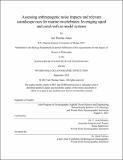Assessing anthropogenic noise impacts and relevant soundscape cues for marine invertebrates: leveraging squid and coral reefs as model systems
Author(s)
Jones, Ian Thomas
DownloadThesis PDF (23.87Mb)
Advisor
Mooney, T. Aran
Terms of use
Metadata
Show full item recordAbstract
Sound is utilized by marine animal taxa for many ecologically important functions, and these taxa are vulnerable to adverse effects of anthropogenic noise on hearing and behavior. However, little is known about marine invertebrates’ responses to anthropogenic noise, and the ambient environmental sounds (“soundscapes”) they detect and respond to. Most acoustic studies report sound pressure (detected by mammals and some fish), but few report particle motion, the back-and-forth vibratory component of sound detected by marine invertebrates. I investigated invertebrate use of and response to sounds in two facets: 1) behavioral responses of longfin squid, Doryteuthis pealeii to anthropogenic noise, and 2) particle motion of coral reef soundscapes in the U.S. Virgin Islands. In laboratory-based experiments I exposed D. pealeii to construction noise originally recorded from an offshore wind farm. I found significant increases in squids’ alarm responses and in failed prey capture attempts during noise. Conversely, noise exposure had no significant effects on reproductive behaviors of groups of D. pealeii, indicating high motivation of these squid to reproduce during this stressor. Collectively, these experiments revealed the importance of considering behavioral context in studies and regulatory decisions regarding invertebrates’ susceptibility to anthropogenic noise impacts. In studying coral reef soundscapes, I reported particle motion trends over several months for coral reefs varying in habitat quality, including coral cover and fish abundance. I found acoustic properties over which particle motion closely scaled with pressure, and others over which it did not. I compared soundscape data with particle motion hearing thresholds, and found that invertebrates may only detect high amplitude and low frequency transient sound cues on reefs, such as those produced by fishes. My research bring new insights on natural and anthropogenic sound cues detectable by marine invertebrates, and how and when invertebrates will be vulnerable to anthropogenic noise pollution.
Date issued
2021-09Department
Massachusetts Institute of Technology. Department of Biology; Woods Hole Oceanographic InstitutionPublisher
Massachusetts Institute of Technology